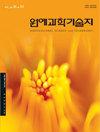露地栽培红肉龙果(Hylocereus polyrhizus)的花形态及授粉过程
IF 0.8
4区 农林科学
Q3 HORTICULTURE
Korean Journal of Horticultural Science & Technology
Pub Date : 2021-06-01
DOI:10.7235/HORT.20210025
引用次数: 1
摘要
多水螅,通常被称为红肉火龙果,是一种奇异的水果作物,其商业水果产量在很大程度上取决于水果重量,通常需要种植者的干预才能实现最佳水果产量。本研究的目的是利用光镜、扫描电子显微镜和荧光显微镜对露地生长的红肉龙果实的花结构、花粉和柱头的形态,以及花粉-柱头相互作用和花粉管生长的繁殖过程进行表征。多水杉的花朵代表了仙人掌科的花朵特征,其中夜间开花的白色大花朵伴随着强烈的花朵散发。开花期的延长也表明夜间和日间传粉者的混合授粉综合征。植物的自交不亲和性表现为性器官的空间分离,接近两性生殖和干式柱头。位于花药上方的许多柱头裂片形成了一个大面积,增强了大量花粉的沉积。花粉的高度装饰、针叶树状雕塑在花粉粒附着和粘附在柱头上起着至关重要的作用,乳头表面的膜是干式柱头花粉管生长的特殊适应。花粉在授粉后两小时发芽,花粉管在乳头组织下伸长。授粉后1天可以观察到不育花粉粒或不亲和授粉,如花粉粒塌陷或脱水所示,而在授粉后2天观察到亲和花粉粒向下穿过花柱传递组织。授粉后,大部分花粉管花了大约4天的时间到达子房腔,并使胚珠受精,最终结实。附加关键词:干燥柱头、外壁、乳头、花粉-柱头相互作用、自交不亲和本文章由计算机程序翻译,如有差异,请以英文原文为准。
Floral Morphology and Pollination Process of Red-fleshed Dragon Fruit (Hylocereus polyrhizus) Grown in an Open Field
Hylocereus polyrhizus, commonly known as red-fleshed dragon fruit, is an exotic fruit crop whose commercial fruit production depends to a great extent on fruit weight, often with the grower’s intervention for optimal fruit production. The purpose of this study was to characterize the floral structure, the morphology of pollen and stigma, and the reproductive process involving pollen-stigma interaction and pollen tube growth in red-fleshed dragon fruit plant grown in an open field using light, scanning electron, and fluorescence microscopy. Flowers of H. polyrhizus typified the floral traits of Cactaceae, in which large and white-coloured flowers with nocturnal anthesis are accompanied by strong floral emission. The extension of floral anthesis also indicated mixed pollination syndromes of nocturnal and diurnal pollinators. Self-incompatibility of the plant is evidenced by spatial segregation of the sexual organs with approach herkogamy and dry-type stigma. Numerous stigma lobes positioned above the anthers create a large area that enhances a large amount of pollen deposition. The highly ornamented, echinate sculpture of the pollen plays crucial roles in the attachment and adhesion of pollen grains on the stigma, and the presence of pellicles on papillae surfaces are specialized adaptations for pollen tube growth in dry-type stigma. The pollen germinated two hours after pollination with pollen tube elongation underneath the papillae tissues. Infertile pollen grains or incompatible pollination can be observed at 1 day after pollination (DAP), as indicated by the collapsed or dehydrated pollen grains, whereas compatible pollen grains travelling downward through the style transmitting tissues were observed at 2 DAP. After pollination, most of the pollen tube took approximately 4 days to reach the ovary cavity and fertilized the ovules leading to eventual fruit set. Additional key words: dry stigma, exine, papillae, pollen-stigma interaction, self-incompatibility
求助全文
通过发布文献求助,成功后即可免费获取论文全文。
去求助
来源期刊
CiteScore
2.00
自引率
0.00%
发文量
0
审稿时长
1 months
期刊介绍:
Horticultural Science and Technology (abbr. Hortic. Sci. Technol., herein ‘HST’; ISSN, 1226-8763), one of the two official journals of the Korean Society for Horticultural Science (KSHS), was launched in 1998 to provides scientific and professional publication on technology and sciences of horticultural area. As an international journal, HST is published in English and Korean, bimonthly on the last day of even number months, and indexed in ‘SCIE’, ‘SCOPUS’ and ‘CABI’. The HST is devoted for the publication of technical and academic papers and review articles on such arears as cultivation physiology, protected horticulture, postharvest technology, genetics and breeding, tissue culture and biotechnology, and other related to vegetables, fruit, ornamental, and herbal plants.

 求助内容:
求助内容: 应助结果提醒方式:
应助结果提醒方式:


